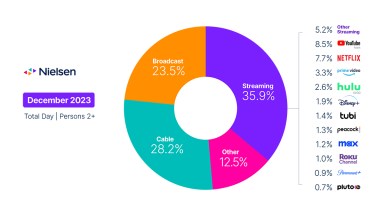Where brands show up for consumers is just as important as how they show up. Inclusive content paired with inclusive brand messaging can be a powerful combination, but many diverse communities struggle to find content that they can relate to.
The growth of streaming is undeniable, but traditional television programming remains the primary option for audiences globally. And while diversity in advertising with LGBTQ+ themes is becoming more common, traditional TV programming offers very limited content for this community. As of April 2023, there were only 416 program titles1 on linear television that include video descriptor metadata2 indicating some level of LGBTQ+ representation (theme, topic, character, etc.).
On streaming platforms, LGBTQ+ audiences have nearly seven times more inclusive content to choose from (2,777 titles), bringing the total across linear and streaming platforms to 3,193 video titles as of late April 2023. Yet despite the ever-widening amount of choice across the media landscape, the number of new LGBTQ+ inclusive titles in 2020, 2021 and 2022 declined after peaking in 2019.
The decline in LGBTQ+ representation in content reflects two distinct dynamics that will shape the future of the video industry in years to come:
- Reduced content production amid economic uncertainty, layoffs throughout the industry, the writer’s strike in the U.S. and the fight to stay afloat following the bursting of the streaming bubble.
- The increasing importance of descriptive-rich video metadata, which is critical in helping viewers discover relevant content as the wealth of available content grows. Nielsen’s most recent U.S. streaming content consumer survey3, for example, found that adults now spend 11 minutes and 16 seconds looking for something to watch, which is up 52% from March 2019.
As media companies scale back production and think more strategically about content, it goes without saying that content aimed at specific audiences will be more affected than content developed for broad audiences—but that may be a misguided approach. According to the latest Where We Are on TV Report from GLAAD, 175 LGBTQ characters will not be returning year-over-year with 140 of those specifically on series which were canceled or otherwise ended.
Separately, in an independent study, online publication Them analyzed the shows that went off the air last year and identified 30 that featured LGBTQ+ characters. Of these 30, 21 featured queer women characters. Although tough business decisions are being made, platforms and content distributors should pay special attention to how they are narrowing or expanding representation of historically excluded communities.
We know from our research that audience-inclusive content does appeal to wide-ranging viewers. In our 2022 Attitudes on Representation on TV study in the U.S., we found that 87% of audiences are interested in watching shows featuring people from outside their own identity group. Among viewers 25-34, 15% say they’re “extremely interested.”
9-1-1: Lone Star is a diamond in the rough, given that linear TV programming offers notably less LGBTQ+ inclusive content than streaming services. This FOX drama, which just ended its fourth season, features three lead characters who identify as LGBTQ+, one of whom is a transgender male. The show, which is a spinoff from the original 9-1-1, is also a huge hit with broad audience appeal, as it attracted 8.7 million minutes of viewing among adults 18 and older4 in 2022.
Streaming platforms account for 87% of the LGBTQ+ inclusive content available to audiences, and that’s not lost on audiences. LGBTQ+ audiences view movies and programs on streaming platforms as notably more non-inclusive than movies and programs on streaming services—and so do heterosexual audiences.
Importantly, increased inclusion isn’t limited to increased or new productions. Yes, audiences would relish an infusion of new inclusive content, but there are ways media can boost representation within existing production and marketing plans. For example, LGBTQ+ audiences universally believe that avoiding stereotyping in content is the best way to improve inclusivity in content. The media industry can take the lead here.
For additional insights, download our recent LGBTQ+ report.
Sources
1Gracenote Global Video Data
2Metadata is the data about a specific program, such as content description, cast, crew, original air date, production countries and description languages. Video descriptors are assigned to the programming that is most popular among viewers.
3Sept. 22, 2022-Oct. 5, 2022 via online survey.
4Nielsen National TV panel, 2022; adults 18 and older; live +35



